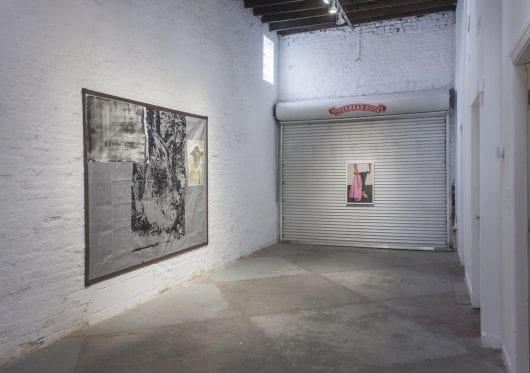
Pedram Sazesh and Sujung Chang’s pieces mounted in the 934 gallery space. Credit: Courtesy of Pedram Sazesh
The 934 Gallery hosts an exhibition of old work becoming new — expressing everchanging meanings and views that form from a mutual understanding of the artists’ lives.
Sujung Chang and Pedram Sazesh have combined their works in “A Mobius Strip on the Sand,” a joint show that aims to give viewers a sense of multidirectionality and experiential evolution.
The artists said that the work is meant to transcend the idea of linear time and space which they have achieved through mixed mediums. These mediums include variations of ink drawings, paintings, photography and mechanized painted silicone.
They also said the pieces in the small space speak to a much larger understanding of the artists’ current lives and pasts.
“A Mobius Strip on the Sand” refers to a sense of looking in all directions on a shifting ground, as a mobius strip is defined as a rectangular design twisted 180 degrees.
“The mobius strip wasn’t about being disoriented, but being unoriented, so somehow not having a proper orientation,” Sazesh said.
The show first appeared on Sazesh and Chang’s horizon when Sazesh submitted the pieces of text that would become part of his work to the gallery curators in 2017. A year later, they contacted him with an invitation to show at the space. Sazesh said that because the writings were a large part of his relationship with Sujung, he wanted to present both their works together.
For Chang and Sazesh, the work reflects periods in their lives when they created art that held certain meanings for them, and although those meanings have changed, the art is still relevant in other ways.
Sazesh’s pieces are a collection of drawings and writing fixed to large brown and grey tarps.
“[I work with] materials that are kind of really old in a way but had never had a trajectory to be on their own, but still recognizing how significant they were for me,” Sazesh said.
For the show, Chang drew on her fascination with combinations of words into a visual form. Motioning to her silicon sculpture of a pufferfish rhythmically flopping in the center of the floor, Chang said she thought about fish before the idea developed into a dying fish.
“I wanted to make a fish that’s always dying but never going to die,” Chang said.
Sazesh’s contributed works are manifestations of his anxiety first of coming to the United States and then of figuring out how to stay.
“Some of it’s personal, some of it’s like self-help,” Sazesh said. “There’s everything in there. It’s uncontextualized thinking, kind of. And what had developed from that text was our conversations.”
Chang and Sazesh met at an artist residency in Maine. They were both living in New York but had not known each other until they were introduced through the program. During a writing exercise, the pair quickly found that their artistic visions and outlooks on life were parallel.
They first started interacting by talking about the “speed of body,” which Chang said is an abstract idea that is not just running space of walking speed.
“But then Pedram literally wrote about the speed of body,” Chang said. “And after residency, we were both going back to New York. So, we started to talk about what it means to be a foreigner in the United States.”
The gallery is located at the 934 Gallery on Cleveland Ave and is available to view until March 15.


